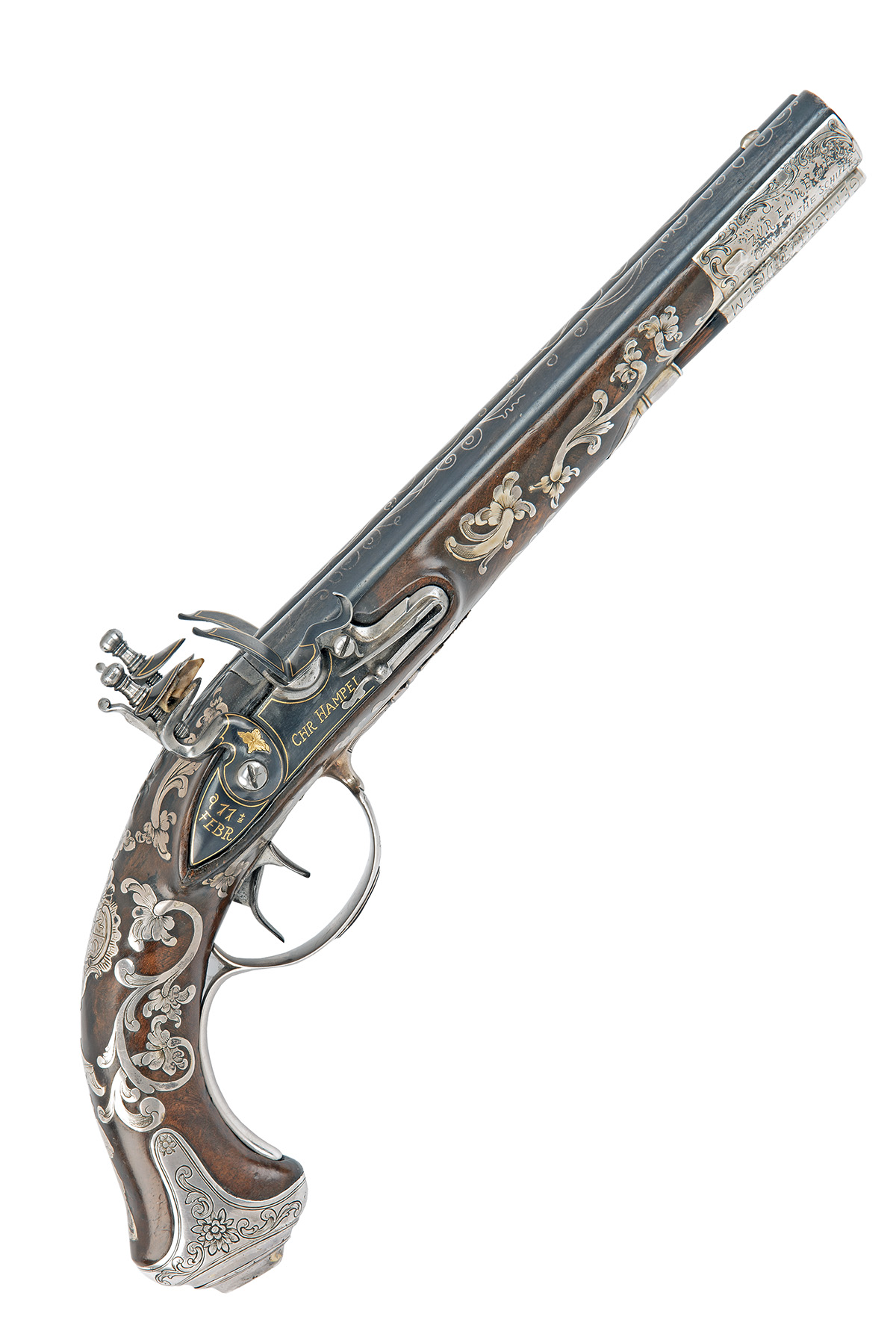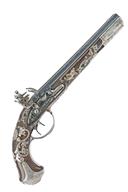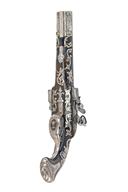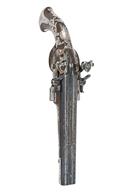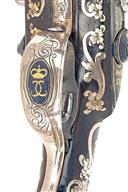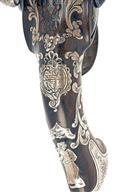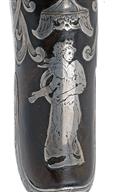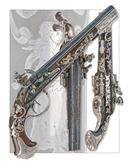Product Details
A FINE SILVER-MOUNTED PRESENTATION 32-BORE DOUBLE-BARRELLED FLINTLOCK PISTOL SIGNED CHR. HAMPEL, LUDWIGSBURG,
dated for 1782, with blued side by side 8 1/2in. barrels signed in gilt on the top-rib 'CHR HAMPEL A LUDWIGSBURG', each barrel inlaid with silver wire scrolls, silver fore-sight, shallow sighting groove to the short top-tang, blued polished locks with gold wire borders and signed 'CHR HAMPEL' below the pans, the lock tails inlet in gilt '11 FEBR.' on the right and 'ANNO 1782' on the left, both cocks with gold wire borders and floral devices to the breasts, walnut full-stock profusely covered in engraved inlet silver vines and flowers, borderline and florally engraved moulded butt-cap, the back of wrist inlet with a silver engraved silhouette of a scantily clad maiden, the trigger guard bow engraved and mounted with a gold monogram of two entwined 'C's' surmounted with a crown on a blue oval escutcheon, long engraved silver nose-cap inscribed '11 FEB ANNO 1782' and 'ZUR EHRE DER CARL HOHE SCHULE' (In Honour of the Carl Hohe School) and silver mounted ebony ramrod, the tip further inscribed 'ZU STUTGART HAT MAN MICH GEMACHT ZU DISEM FESTLICHEN TAG' (I was made in Stuttgart for this festive day)
Provenance: Sadly, the recipient of this fabulous pistol is unknown, but the inscription alludes to the Carl Hone Military School, just outside Stuttgart and was almost certainly given as a birthday present.
The later Hohe Karlsschule in Stuttgart (also as Carlsschule Stuttgart) was founded in 1770 by Duke Carl Eugen as a military nursery in the ducal pleasure palace Solitude near Gerlingen (Württemberg). It served as a military academy, art academy and later as a general college and was intended as an elite school for sons from respected Württemberg families in order to bind them to the court in unconditional obedience and to train them into the leadership elite. In 1781 it was refounded by Emperor Joseph II and was elevated to a university and called Karl's High School.
The Karlsschule, now the Military Academy, was moved from Solitude Palace to Stuttgart in 1775. The school building behind the New Palace, up until then a barracks, was largely destroyed by bombs during the Second World War and then completely destroyed in 1959 when it was demolished to make way for the new corridor of the B14 highway. The building and its location is depicted on a memorial plaque next to the Academy Fountain.
The school was noted for its authoritarian educational methods which provoked resistance from some students. For the pupils, uniforms were compulsory. Wearing wigs was mandatory. According to the surviving documents, the following was the daily routine for serving students:
Get up at 5 a.m. in summer, 6 a.m. in winter, then mustering, report, breakfast, then lessons 7 a.m. to Midday. 1 p.m. lunch ended, followed by a departmental walk in the presence of supervisors and then again lessons from 2 p.m. to 6 p.m. A recovery session was executed from 6 p.m. to 7 p.m. that was then followed by mustering, rapport and dinner at 7:30 p.m. Bedtime was scheduled for 9 p.m. On Sundays, longer walks were possible under the supervision of officers. Visits to relatives were allowed just as rarely as holidays. There were no holidays.
Of the 1496 pupils who attended the Academy, 140 went on to pursue military careers. A relatively large number of them, 33, became Generals. Among them were Generalmajor Joseph von Theobald, (Württ.) Generalmajor Karl Freiherr von Kerner and Württ. Minister of War and General of the Infantry, Frederick of Franquemont
Please click HERE to view Terms & Conditions. Please note all Lots are listed in accordance with UK Law, for overseas buyers, please ensure you are familiar with your relevant local firearms and customs regulations before bidding.
Estimate £4,000-6,000

